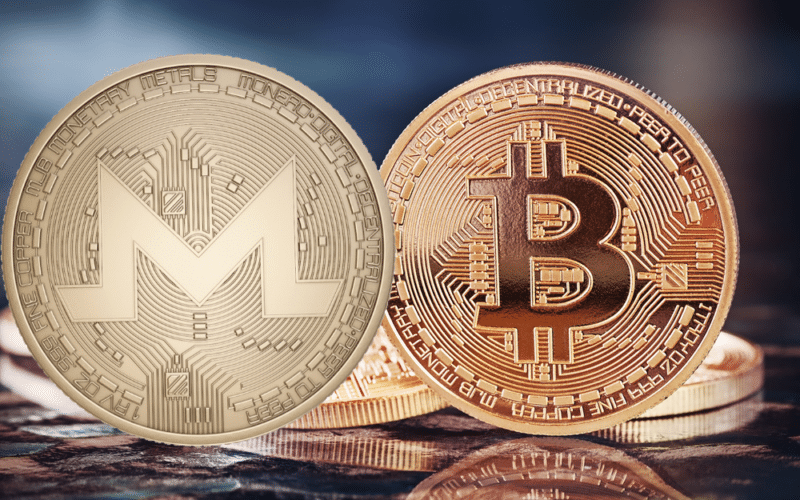Bitcoin and Monero are pretty popular, but what are the differences between the two? in this article, you’ll discover the primary technical distinctions with both cryptocurrencies.
Bitcoin and Monero are among the most well-known cryptocurrencies in the industry. Although Bitcoin is far more prominent than its competitor, many have begun seeing some inherent flaws, one of them being its privacy; this is where Monero steps in.
With many experts advocating more privacy measures for data protection in everyday life, Monero has become an essential addition to the market. This article will cover the main differences between Bitcoin and Monero to help users understand their main advantages and disadvantages.
A brief history of Bitcoin and Monero
| BITCOIN | MONERO | |
| Original author/s | Satoshi Nakamoto | Nicolas van Saberhagen |
| Date released | 03 January 2009 | 18 April 2014 |
| Price (as of 17/06/2021) | $ 38 800 | $ 270 |
| Ticker symbol | BTC | XMR |
| Consensus mechanism | Proof-of-work | Proof-of-work |
| Hashing algorithm | SHA-256 | RandomX |
| Block generation time | 10 minutes | 2 minutes |
| Halving | Yes | No |
| Supply limit | 21 million | N/A |
Interestingly, the founders of both Bitcoin and Monero still remain mysterious. Everyone by now has probably heard of Bitcoin as the world’s first official cryptocurrency launched at the start of January 2009 by the pseudonymous Satoshi Nakamoto.
The goal of Bitcoin was to create a decentralized peer-to-peer currency using cryptography where the power shifted from financial institutions and governments to ordinary folks. It is fair to say Bitcoin inspired thousands of altcoins and gave developers innovative ideas to develop cryptocurrencies beyond just being money.
One of these inventions was a coin focused on privacy, to which Monero was one of the first popularly recognized. The developers of Monero were clearly inspired by Bitcoin, even to the point where the project was previously known as Bitmonero (with ‘bit’ from Bitcoin and Monero meaning ‘coin’ in the Esperanto language).
Also, research suggests the early contributors, who are only known by aliases, came from the Bitcointalk forum. The creators saw Bitcoin’s lack of privacy as a fundamental flaw. So, using cryptographic technology known as CryptoNote designed for anonymous transactions, they sought to develop Monero, officially released on 18 April 2014.
So, where do Bitcoin and Monero primarily differ?
We should look at privacy, fungibility, transaction time/cost, and mining accessibility when observing the notable distinctions.
Privacy
Privacy is probably the main differentiator between Bitcoin and Monero. Contrary to popular belief, coins like Bitcoin do not provide complete anonymity but are rather pseudonymous.
While public addresses do not inherently reveal real-world identities, some identification is possible by looking at Bitcoin’s block explorer. So, Bitcoin is only slightly anonymous as every forming block is publicly verifiable on the blockchain.
In contrast, Monero is wholly anonymous as transactions cannot be linked to an identifiable source. Monero achieves this attribute primarily with stealth addresses, one-time generated addresses used by senders for every transfer.
So, when multiple transactions occur between two parties, they cannot, through ordinary means, be traceable whatsoever. Monero also employs confidential ring transactions responsible for hiding the amount of XRM transacted in a block.
Although Monero provides transparency like Bitcoin via a block explorer, it is still more private because of its technologies.
Fungibility
Another distinction many might not realize between Bitcoin and Monero is their fungibility, meaning one unit of money is interchangeable with another unit of money. In simpler terms, 1 BTC will always equal 1 BTC regardless of where it comes from or its denominations, i.e., two 0.5 BTC or four 0.25 BTC still equate to 1 BTC.
Technically, all cryptocurrencies are fungible in this manner with normal circumstances. However, if a BTC is associated with unwelcome activity, it may be blacklisted due to being detectable on the blockchain.
Contrastingly, Monero does not have this issue since XMR transfers are totally independent of one another because of the obfuscation. Although, this very attribute makes it beneficial for illegal transactions, which is one of Monero’s drawbacks.
Transaction time and cost
Even though both cryptocurrencies employ proof-of-work or mining, Monero is far superior to its counterpart regarding transaction time and cost. Each block on Bitcoin has historically taken 10 minutes to form.
Depending on the exchange or wallet service receiving the BTC, further confirmations for extra verification typically increase the clearing time to an hour or sometimes longer with congestion. BTC transfers have also been known to be a bit more expensive than normal during these busy periods.
As of 17 June 2021, the average cost for a BTC transfer is $6.44, according to BitInfoCharts. On the other hand, each XRM block forms roughly every two minutes. If we add further confirmations, this can increase to 20 minutes.
At the time of writing, the average transaction fee with Monero is $0.07, tremendously lower than Bitcoin. All in all, Monero is quicker and cheaper.
Mining accessibility
Miners are integral to any cryptocurrency employing the proof-of-work consensus mechanism as they are responsible for adding blocks and securing their respective networks.
Over the last few years, Bitcoin has gained a reputation for being somewhat centralized. Much of its hashing power comes from China due to its cheap electricity and access to ASICs (application-specific integrated circuits).
Miners can perform mining mainly using CPUs (central processing units), GPUs (graphical processing units), and ASICs.
ASIC devices are very expensive and require considerable maintenance but possess incredibly astronomical hashing functions. Due to the ever-increasing competitiveness of mining, such machines have become the standard for many coins.
However, Monero’s developers have worked to keep ASICs at bay from their network, making mining more egalitarian even for hobbyists who cannot afford these machines.
Final word
This article should have conclusively shed light on the main differentiators between Bitcoin and Monero. In summary, let’s recap how Bitcoin and Monero are similar and distinct from each other.
- Bitcoin and Monero are both peer-to-peer decentralized digital currencies, but Bitcoin is more popular.
- Monero is privacy-focused and wholly anonymous, while Bitcoin is only pseudonymous.
- Bitcoin is somewhat fungible, while Monero is entirely fungible because of the anonymity.
- Monero is much quicker in transaction speed and cheaper than Bitcoin.
- Bitcoin has technically become less centralized due to the dominance of ASIC miners, while Monero supports accessible mining with CPUs and GPUs, making it more decentralized.
Read also: 7 Best Binance Indicators for Crypto Trading








